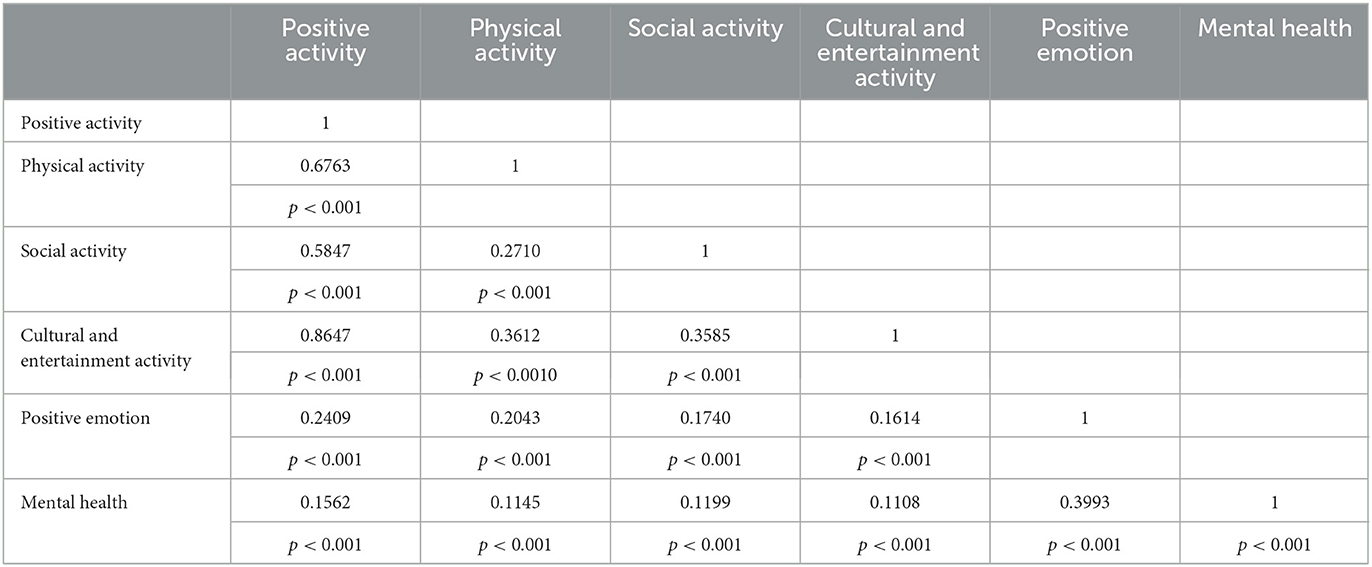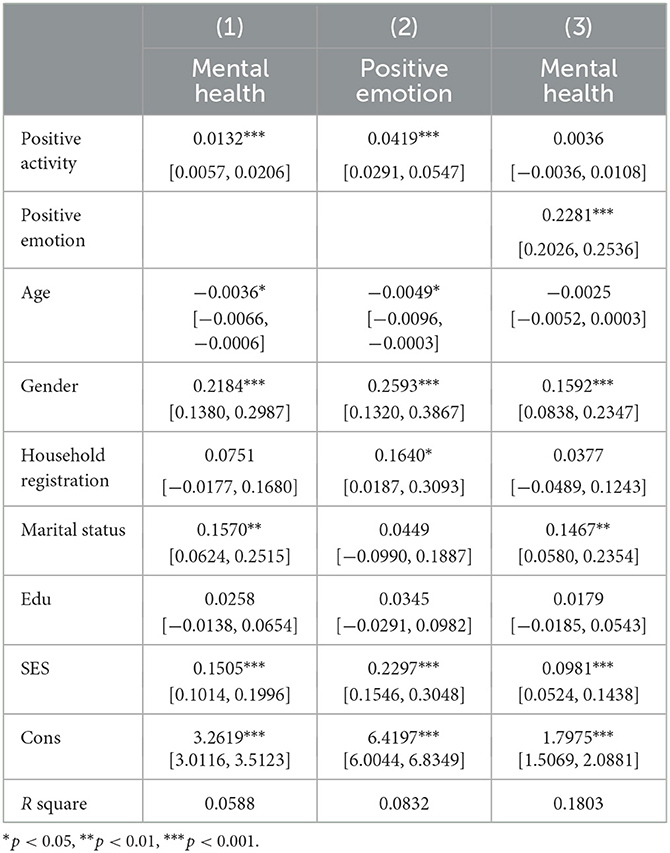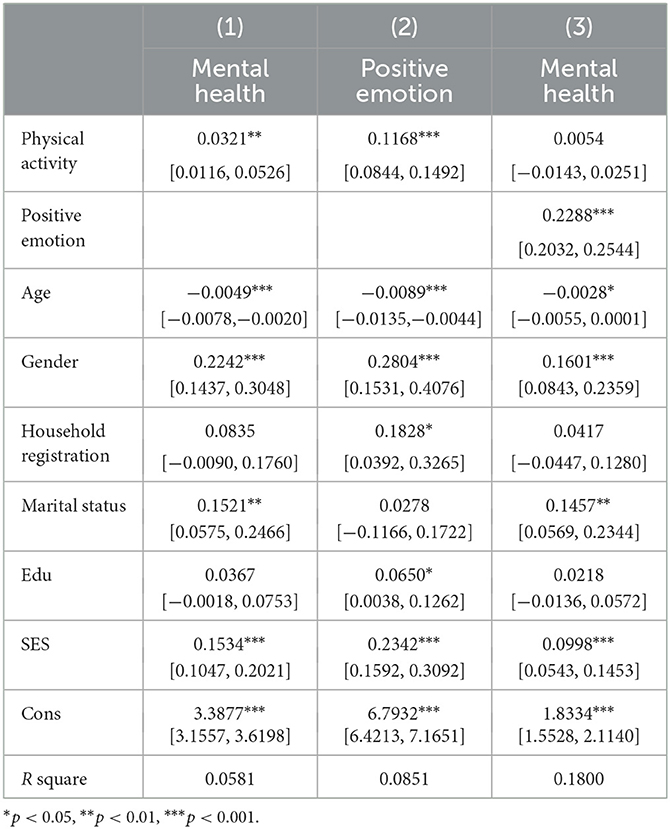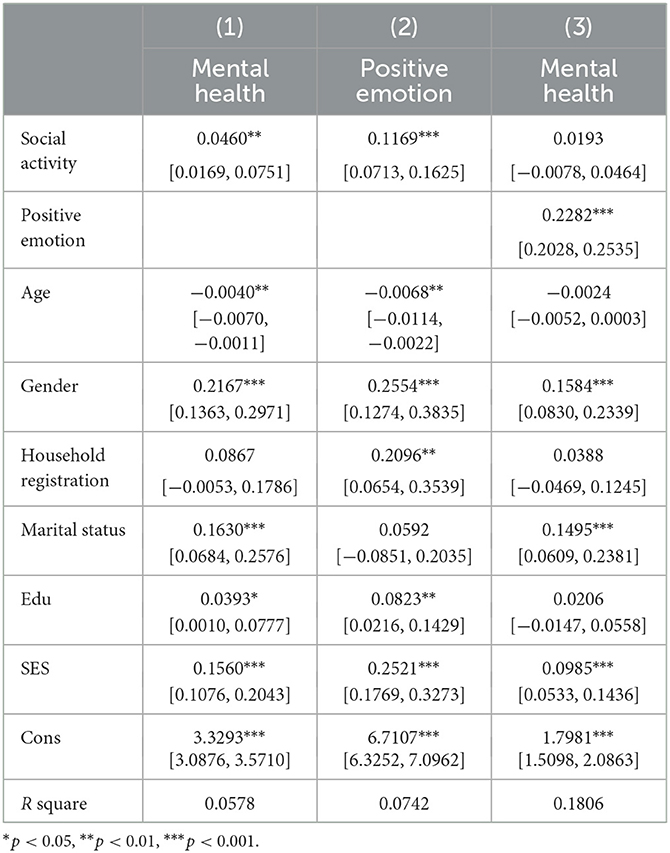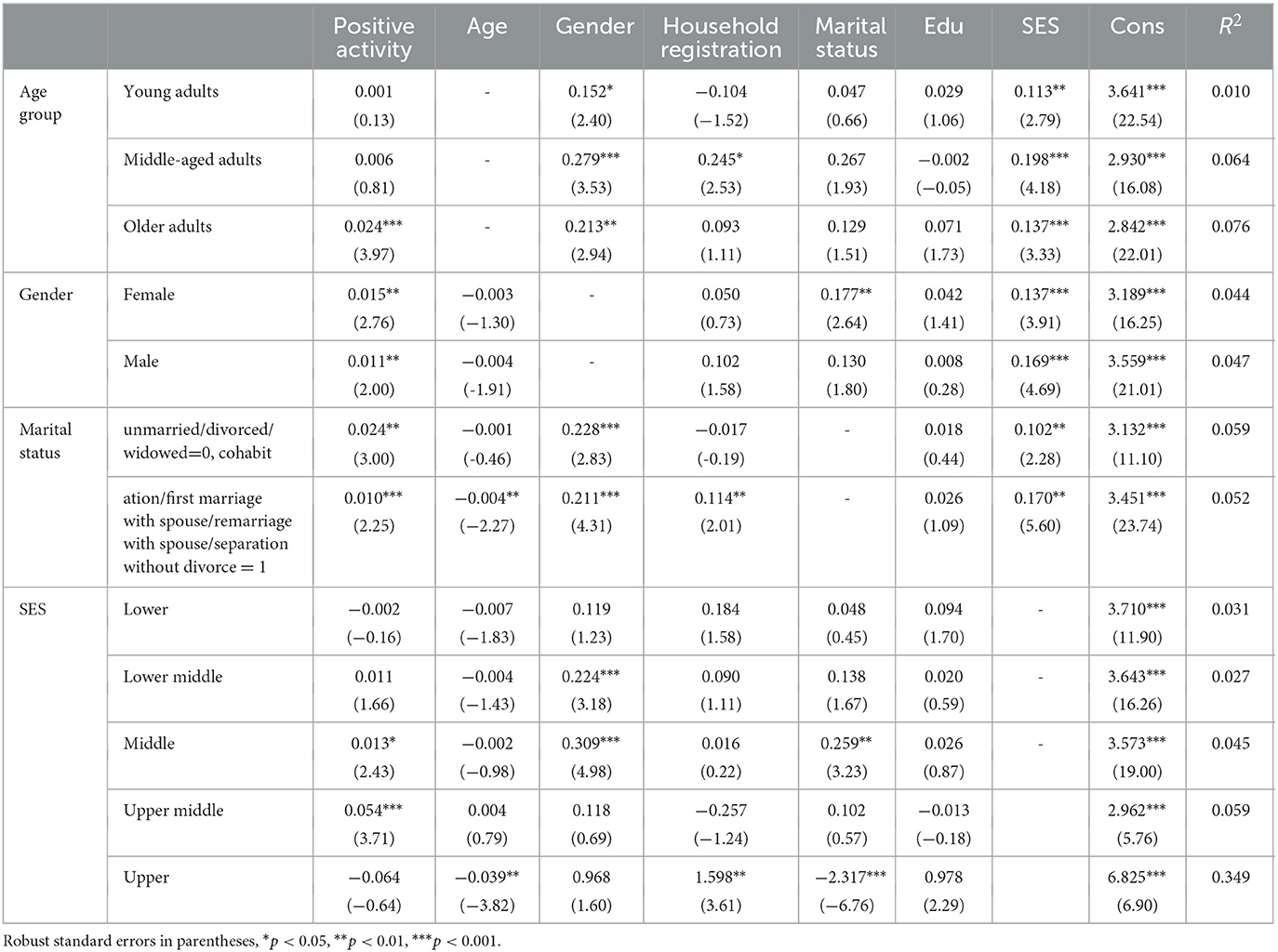- School of Medicine and Health Management, Tongji Medical College of Huazhong University of Science and Technology, Wuhan, Hubei, China
Objective: Mental health has become a widely concerned topic worldwide. However, the impact and mechanism of positive activities on mental health still needed to be explored. This study aimed to apply the positive-activity model to investigate the effect of participation in positive activities on mental health and the mediating role of positive emotion.
Methods: This study used data from the 2021 China Comprehensive Social Survey (CGSS) and included 2,581 individuals. Ordinary Least Squares (OLS) and a three-step method was used for analysis.
Results: The average of positive activities was 15.83. The positive activities affected positively mental health (β = 0.0132, p < 0.001). The positive emotion played a mediating role (β =0.2281, p < 0.001). The effect of positive activities on mental health was significant in older adults group (β = 0.024, p < 0.001), female (β = 0.015, p < 0.01) and male group (β = 0.01, p < 0.01), unmarried/divorced/widowed group (β = 0.024, p < 0.01), cohabitation/first marriage with spouse/remarriage with spouse/separation without divorce group (β = 0.010, p < 0.001), middle(β = 0.013, p < 0.05), and upper-middle-level SES group (β = 0.054, p < 0.001).
Conclusions: We concluded that the participation level of positive activities still needs to be improved and positive activities improve mental health through positive emotion, which implied that positive activities, as an easily implementable measure, should be greatly encouraged in mental health policies. And older adults, female, people without spouse, middle and upper-middle-income individuals need to be paid more attention.
1 Introduction
As perceptions of health have changed, mental health has become as important as physical health and cannot be ignored (1), which affects personal development, quality of life, daily life functions, etc. (2, 3). However, poor mental health has become a global public health issue. According to the report released by the World Health Organization (WHO) in 2022, 970 million people globally suffered from mental disorders in 2019 (4). Mental illness can lead to serious economic, social, and political problems (5). Addressing mental health issues has become a key priority for public health programs (6). Therefore, it is necessary to pay attention to the topic of mental health.
The positive activity model proposed by Lyubomirsky and Layous explains the relationship between positive activity and wellbeing, and suggests that positive emotion can mediate the relationship between positive activity and wellbeing (7). Positive activity is defined as simple, low-cost, self-managed, purposeful, and regular practices, which can enhance the sense of wellbeing (7). Positive activities include various forms such as communication with friends, exercise, and dancing (8). The positive activity model has been used to explain the impact of different forms of positive activity on individuals' thoughts. For example, nurses using their strengths at work can reduce their depression levels (9). People who participate in square dancing for a longer period of time have a better overall feeling of life quality (10). These studies suggest that certain positive activities can increase healthy thoughts. Therefore, we argued that positive activities can affect mental health via positive emotion based on the positive-activity model.
Participating activities is widely advocated and practiced globally to promote health (11, 12). However, the effect of participating in positive activities on mental health still needs to be explored. Previous researches shown that positive activities have an impact on mental health. But these researches mainly focused on a single type of positive activities, with physical activities and social activities being the most studied (13–16). For example, Hou et al. showed that a higher level of physical activity was associated with better mental health (15); some studies suggested that people who engage in more social activities have better mental health (16). There are also a few studies on the impact of various types of leisure activities on mental health, in which various types of activities included physical exercise, social activities, mental activities, reading, sewing, etc. (16–19). However, despite some of these researches, in terms of the type of positive activities, activities such as reading, watching TV, and shopping have received little attention. Thus, it is necessary to include these forms of activities in the study. In addition, existing researches on the impact of activities such as reading and watching TV on mental health has yielded inconsistent results (18, 20, 21), which indicated that more evidence is still needed. Therefore, it is urgent and valuable to assess the impact of overall level of participation in positive activities and various types of positive activities on mental health for enriching relevant research evidence, enriching the evidence-based application of positive psychology and improving mental health policies.
Although the correlation between participation in positive activities and mental health has been studied, the mechanism still needs to be explored. Previous studies have shown that positive emotion can mediate positive activities and positive outcomes. For example, Pradhan et al. used the positive activity model to explore the positive impact of spirituality at workplace on engagement and the mediating role of emotional intelligence (22). Zhang et al. also used this model to explore the impact of square dancing on the quality of life of older adults and the mediating role of their own aging attitudes (10). However, few scholars have studied whether positive emotion can play a mediating role between positive activities and mental health based on the positive-activity model. Previous studies have suggested that positive emotion may play a mediating role. On the one hand, previous studies have indicated the impact of positive activities on positive emotion. For example, Chen et al. believed that participating in leisure activities promoted the accumulation of psychological resources such as increasing optimism and their research showed that participating in leisure activities was positively correlated with a higher level of emotional health (23). Ba et al. found an association between time allocated to daily activities/social interactions and the duration of positive emotion (24). A qualitative study in Canada suggested that participating in various activities can help individuals focus on their own time, generate a series of positive emotion (25). On the other hand, positive emotion can improve mental health. Positive emotion is a short-term feeling but the benefits brought by it can accumulate and compound, bringing changes in people's thoughts, behaviors and psychological responses, predicting thriving mental health (26, 27). Therefore, our study explored the potential mechanisms of the effect of positive activities on mental health, with a view to providing a theoretical basis for alleviating mental health problems.
In summary, this study aimed to apply the positive-activity model to investigate the effect of participation in multiple positive activities on mental health and the mediating role of positive emotion. Our research findings can reveal the impact of participation in positive activities on mental health and the mechanism, providing recommendations for promoting mental health.
2 Methods
2.1 Participants
We used data from the 2021 China General Social Survey (CGSS) which is a national, comprehensive, and large-scale social survey project conducted by the National Research Center of Renmin University of China. The survey was conducted using a multi-stage stratified probability proportionate-to-size (PPS) random sampling method, with counties serving as primary sampling units and urban communities and rural villages as secondary sampling units (28, 29). Post-stratification weights were applied to correct oversampling, ensuring that survey results accurately represented the general population in China (30). A total of 8,148 valid samples were recovered from 320 communities and 19 provinces in the 2021 survey. Representative samples have been recognized and widely used by the academic community.
The inclusion criteria for participants in this study were individuals without missing or abnormal values in positive activity, positive emotion, mental health, and sociodemographic variables. After data sorting and screening, 2581 samples were retained. Among the 2581 participants, the average age was 51.89 ± 17.50, 54.71% were female, 54.9% were agricultural household registration, and 27.20% were unmarried/divorced/widowed. The education level of 33.09% of the participants was primary school and below, 28.28% middle school, 17.98% high school, 7.56% junior college, 11.62% undergraduate, and 1.47% graduate and above. The socioeconomic status of 22.01% of the participants was lower level, 32.97% middle lower level, 38.74 % middle level, 5.70% middle upper level, and 0.58% upper level.
2.2 Measures
2.2.1 Positive activities
We measured positive activities by using the question of “The frequency of engaging in the following activities in your free time.” The assignment method is never = 0, several times a year/once a year or less/several times a year or less = 1, several times a month/approximately once a month = 2, 1–2 times a week/several times a week = 3, almost every day/every day = 4, which represents different scores (1, 16, 31). In addition, we classified the types of positive activities in this study into three categories, including physical activities (shopping, participating in physical exercise) (19, 20, 32), social activities (gathering with relatives, meeting with friends) (20, 32), cultural and entertainment activity activities (watching television or videos, going to the cinema, attending cultural events, reading books/newspapers/magazines, listening to music at home, watching live sports, doing crafts, and surfing the internet) (19, 20, 33). The level of participation in various activities was the sum of the scores of included items.
2.2.2 Mental health
According to previous research (16, 34), “In the past 4 weeks, how depressed or frustrated did you feel?” was used to measure mental health. Responses were coded based on a 5-point Likert scale (1 = always, 5 = never). The higher the score, the better the mental health.
2.2.3 Positive emotion
Positive emotion refers to “one's level of pleasurable engagement with the environment” and includes feelings such as “good,” “positive,” “pleasant” (35). In the CGSS database, “Do you feel calm” and “Are you full of energy” are used to measure participants' feelings over the past 4 weeks. Therefore, based on the relevant studies (29) and definition of positive emotion, we used these two questions to measure positive emotion. We coded this variable in a manner consistent with “mental health.” The score of positive emotion is the sum of the scores of two items, with a score range of 2–10.
2.2.4 Control variables
The control variables in this study included age (a continuous variable), gender (female = 0, male = 1), household registration (Agricultural household registration = 0, Non-agricultural household registration = 1), education (Edu, primary school and below = 1, junior high school = 2, high school/technical school/polytechnic school = 3, college = 4, undergraduate = 5, graduate and above = 6), marital status (unmarried/divorced/widowed = 0, cohabitation/first marriage with spouse/remarriage with spouse/separation without divorce = 1), and socioeconomic status (SES, upper level = 5, upper middle level = 4, middle level = 3, lower middle level = 2, lower level = 1).
2.3 Statistical analysis
Firstly, we adopted descriptive statistics on positive activities, mental health, positive emotion, and control variables. Secondly, we conducted a correlation analysis between variables. Thirdly, we used Ordinary Least Squares (OLS) to estimate the impact of positive activity on mental health and the three-step method to determine the mediating effect of positive emotion. Before conducting Ordinary Least Squares (OLS) regression, we conducted heteroscedasticity tests and used Robust standard errors regression to address the existing heteroscedasticity issues to obtain more reliable estimation results. The mediating effect was judged based on the criteria proposed by Baron and Kenny (36). According to Baron and Kenny, a mediating effect is determined if the following criteria are met: (a) the predictor variable is significantly correlated with the outcome variable, (b) the predictor variable is significantly correlated with the mediator, and (c) when the predictor variable is included in the model, the mediator variable is significantly correlated with the outcome variable. Finally, we used OLS to analyze the effects of positive activity on mental health in different groups. p < 0.05 was considered statistically significant. STATA version 17.0 was used to conduct all statistical analyses.
3 Results
3.1 Descriptive statistics
The mean of positive activities, physical activities, social activities, and cultural and entertainment activities were 15.83 ± 6.80, 4.43 ± 2.73, 8.40 ± 3.74, and 2.37 ± 1.52, respectively. The mean of mental health and positive emotion were 3.94 ± 1.07 and 7.66 ± 1.71, respectively (see Table 1).
3.2 Correlation analysis
The correlation analysis results show that there is a weak correlation between variables. Positive activity showed a positive correlation with mental health (r = 0.1562, p < 0.001) and positive emotion (r = 0.2409, p < 0.001). Physical activities (r = 0.1145, p < 0.001), social activities (r = 0.1199, p < 0.001), cultural and entertainment activities (r = 0.1108, p < 0.001) all showed a positive correlation with mental health. Physical activities (r = 0.2043, p < 0.001), social activities (r = 0.1740, p < 0.001), cultural and entertainment activities (r = 0.1614, p < 0.001) all showed a positive correlation with positive emotion. Positive emotion also showed a positive correlation with mental health (r = 0.3993, p < 0.001, see Table 2).
3.3 The mediating role of positive emotion in the impact of positive activities on mental health
The results of the mediation test are shown in Table 3. In the regression model without mediating variables, it was determined that positive activities positively affected mental health (β = 0.0132, p < 0.001). To test the mediating role of positive emotion, it was incorporated into the model. From Table 3, it can be seen that the effect of positive activities on mental health becomes negligible after controlling positive emotion. The positive emotion has a positive effect on the positive activities (β = 0.2281, p < 0.001). According to Baron and Kenny, it indicated that positive emotion played a fully mediating role. Similarly, we determined the impact of physical activities, social activities, cultural and entertainment activities on mental health, as well as the mediating role of positive emotion. According to Table 4, physical activities had a positive impact on mental health (β = 0.0321, p < 0.01), and positive emotion played a mediating role (β = 0.2288, p < 0.001). According to Table 5, social activities had a positive impact on mental health (β = 0.0460, p < 0.01), and positive emotion played a mediating role (β = 0.2282, p < 0.001). According to Table 6, cultural and entertainment activities have no significant impact on mental health (p > 0.05).
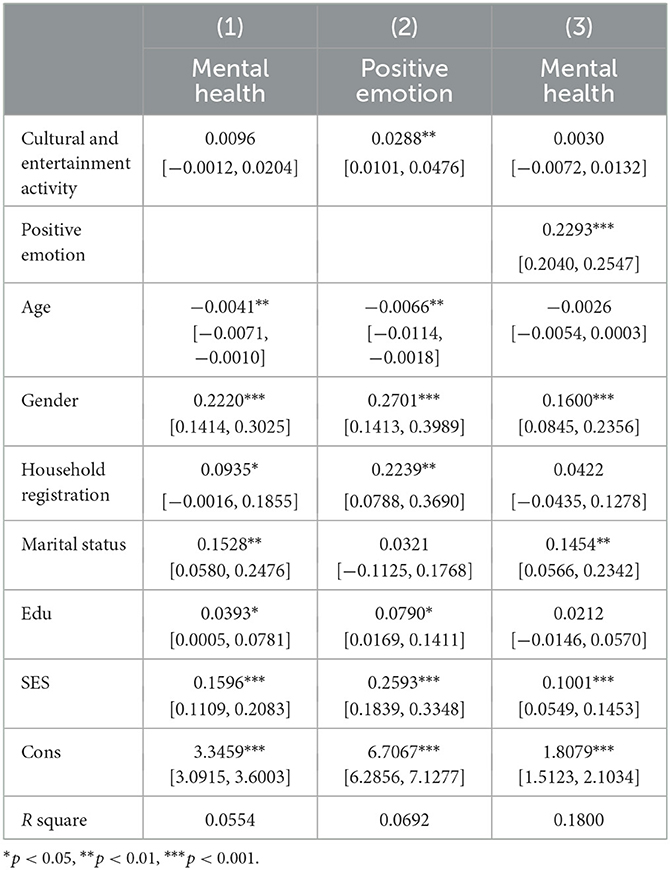
Table 6. The mediating role of positive emotion between cultural and entertainment activities and mental health.
3.4 Grouped regression analysis
According to the results of Table 3, it was found that age, gender, marital status, and SES had a significant impact on mental health. To evaluate the differences between different populations, further grouped regression analysis was conducted. This study divided age into young (18–44), middle-aged (45–59), and older adults (≥60). The regression results showed a positive impact of positive activities on mental health in older adults group (β = 0.024, p < 0.001), female (β = 0.015, p < 0.01)and male group (β = 0.011, p < 0.01), unmarried/divorced/widowed group (β = 0.024, p < 0.01), cohabitation/first marriage with spouse/remarriage with spouse/separation without divorce group (β = 0.010, p < 0.001), middle (β = 0.013, p < 0.05), and upper-middle-level SES group (β = 0.054, p < 0.001; Table 7).
4 Discussion
4.1 Low level of participation in positive activities
In this study, the average of positive activities was 15.83 (with a maximum of 42). A study in the United States reported that the average leisure activity participation level was 24.93 (with a maximum of 50) among adults (23). A study in Japan showed that the average is 17.8 among older adults (with a maximum of 33) (38). Compared to these researches, the average level of positive activity is much lower than the moderate level in our study. The differences in findings may be due to differences in the measurement of positive activities. The measured activities in the study in the United States include physical activities, social activities, spending quiet time alone, spending time unwinding at the end of the day, being in outdoor settings such as gardens, parks, countryside, and so on. In Japanese research, activities measured include physical activity, cultural activity, social activity, as well as travel, creativity, plant cultivation, and so on. The differences in these measurement items may be due to differences in questionnaire design or cultural backgrounds.
4.2 Positive activities positively associated with mental health
Our study found that positive activities have a weak protective effect on mental health. Previous studies also found this positive impact. A study including 3,727 participants reported that the more diverse leisure activities older adults participated in, the lower level their depression risk (37). Scholars pointed out that participation in activities creates an environment conducive to mental health which can help individuals increase their self-efficacy and self-confidence, gain companionship and friendship in their interactions, gain social support, and divert attention from unfavorable stimuli, thereby protecting people from psychological problems (17, 19, 37). However, it has also been shown that mental health can in turn affect an individual's participation in positive activities (39). This bi-directional relationship between positive activities and mental health suggests that we need to pay special attention to individuals who may be withdrawn due to psychological problems when encouraging them to engage in positive activities.
Our research found that different types of positive activities have varying impacts on mental health. Physical activities have a positive impact on mental health, which is consist with other studies (19, 40). Similarly, social activities also have a positive impact on mental health, which has been widely confirmed in previous studies (20, 41). Both physical and social activities showed a weak protective effect on mental health. However, in this study, there was no apparent relationship between entertainment and cultural activities and mental health. The research results on the impact of entertainment activities on mental health are inconsistent. Related studies have shown that engaging in excessive entertainment activities such as watching TV, surfing the internet, reading and writing has not been found to be associated with mental health (18, 19). Other studies concluded that participation in more entertainment activities is beneficial to the mental health (20). Some studies shown that the increase in these activities does not affect mental health, but their decrease can become a risk factor for mental health (42). Therefore, although the impact of different types of activities varies, participating in a wider range of activities may be a more beneficial approach for mental health.
4.3 Positive emotion played a mediating role
Positive emotion mediated the positive effect of positive activities on mental health. The mediating role of positive emotion has been rarely evaluated in previous empirical studies. A qualitative study reported that participating in various activities can help individuals generate a series of positive emotions and thus improve mental health, which is consistent with our finding (25). There is a view that positive activities can mitigate the negative effects of stressful experiences that threaten physical and mental health, and can buffer stressful experiences by promoting positive emotion related to self-actualization and wellbeing, and therefore they can prevent mental illnesses (43). Previous scholars also have studied the relationship between positive activity and positive emotion, as well as positive emotion and mental health, respectively. A study reported that participating in social interactions can experience stronger positive emotions than being alone, whether the participants take part in face-to-face interactions or technology-mediated communication (44). A study examining the effect of physical activities on life satisfaction validated the mediating role played by positive emotion, and believed that physical activities promoted the body's secretion of dopamine which is closely related to pleasure, thereby increasing an individual's positive emotional experience (26). A research indicated that positive emotion played a mediating role between gratitude and depressive symptoms, which proved that positive emotion can positively affect mental health (45). Our research provided quantitative evidence for the impact of positive activities on mental health through positive emotion, enriching the application of positive activity model, and suggested that positive emotion can mediate the positive effects of physical and social activities on mental health. Our findings suggest that encouraging participation in positive activities and improving positive emotion are important ways to improve mental health.
4.4 Further discussion
We divided the samples into several groups for further discussion. Firstly, positive activities had a positive impact on mental health among older adults, which is consistent with relevant studies (46). One possible reason is that older adults are able to gain greater value from leisure activities due to the limited opportunities to participate in society. Secondly, positive activities have a positive impact on the mental health of both male and female group, but in terms of the coefficients, the positive impact on the female group is greater than that on the male population. The relevant research is consistent with our finding (47). This result may be due to the different benefits obtained by males and females in participating in positive activities (20, 47). In groups with different marital status, positive activities have a significant positive impact on both groups, but in terms of the coefficients, the impact is greater in the group without spouse. This may be because individuals without spouses are more likely to pay attention to and enjoy the process of participating in activities, so they can gain more benefits in improving their mental health through participating in activities (48). Finally, we found a positive influence among the middle and upper-middle-level SES population. And our study also indicated that when the socio-economic status is at the top, positive activities didn't have a significant impact on mental health.
This study has some limitations. First, causal inference cannot be made due to the cross-sectional design. Longitudinal studies are needed in the future to explore causal relationships. Second, we are unable to investigate a wider range of positive activities because of the limitation of the database and future research can expand the types of positive activities. Third, in terms of measuring variables, mental health was measured using a single item and the measurement of positive emotion did not use standard scales, which needs to be improved in future research.
5 Conclusions
We found that the level of multiple positive activities participation was low, positive activities had a positive impact on mental health, and positive emotion played a mediating role. The impact of positive activities on mental health varies among different types, with physical and social activities having a significant impact on mental health. Our findings also suggested that encouraging participation in positive activities among older adults, female, people without spouse, and middle and upper-middle-income people may lead to better outcomes.
Data availability statement
The original contributions presented in the study are included in the article/supplementary material, further inquiries can be directed to the corresponding author.
Ethics statement
The studies involving humans were approved by Institutional Review Board of Renmin University of China. The studies were conducted in accordance with the local legislation and institutional requirements. The participants provided their written informed consent to participate in this study.
Author contributions
YWa: Conceptualization, Data curation, Formal analysis, Methodology, Software, Validation, Visualization, Writing – original draft, Writing – review & editing. YWu: Writing – review & editing, Validation. QX: Validation, Writing – review & editing. SF: Writing – review & editing, Visualization. JH: Visualization, Writing – review & editing. DZ: Visualization, Writing – review & editing. XZ: Visualization, Writing – review & editing, Conceptualization, Project administration, Supervision.
Funding
The author(s) declare that no financial support was received for the research, authorship, and/or publication of this article.
Acknowledgments
The authors are extremely grateful to all the participants of this study. The authors would also like to express their sincere gratitude to the CGSS research team for their contributions to data collection and all the interviewees who voluntarily participated in the CGSS.
Conflict of interest
The authors declare that the research was conducted in the absence of any commercial or financial relationships that could be construed as a potential conflict of interest.
Publisher's note
All claims expressed in this article are solely those of the authors and do not necessarily represent those of their affiliated organizations, or those of the publisher, the editors and the reviewers. Any product that may be evaluated in this article, or claim that may be made by its manufacturer, is not guaranteed or endorsed by the publisher.
References
1. Zhang C, Qing N, Zhang S. The impact of leisure activities on the mental health of older adults: the mediating effect of social support and perceived stress. J Healthc Eng. (2021) 2021:e6264447. doi: 10.1155/2021/6264447
2. Kusier AO, Ubbesen TR, Folker AP. Understanding mental health promotion in organized leisure communities for young people: a realist review. Front Public Health. (2024) 12:1336736. doi: 10.3389/fpubh.2024.1336736
3. Ong W, Omar NA, Zanudin A, Alias MF, Wen LH, Ee ATX, et al. The relationship between physical activity and mental health among individuals with spinal cord injury: protocol for a scoping review. JMIR Res Protoc. (2024) 13:e56081. doi: 10.2196/56081
4. World Health Organization. Mental Disorders (2022). Available at: https://www.who.int/news-room/fact-sheets/detail/mental-disorders (accessed August 1, 2024).
5. Jenkins R, Baingana F, Ahmad R, McDaid D, Atun R. Social, economic, human rights and political challenges to global mental health. Ment Health Fam Med. (2011) 8:87–96.
6. Wang X, Wu Y, Shi X, Chen Y, Xu Y, Xu H, et al. Associations of lifestyle with mental health and well-being in Chinese adults: a nationwide study. Front Nutr. (2023) 10:1198796. doi: 10.3389/fnut.2023.1198796
7. Lyubomirsky S, Layous K. How do simple positive activities increase well-being? Curr Dir Psychol Sci. (2013) 22:57–62. doi: 10.1177/0963721412469809
8. Tkach C, Lyubomirsky S. How do people pursue happiness? relating personality, happiness-increasing strategies, and well-being. J Hap Stud. (2006) 7:183–225. doi: 10.1007/s10902-005-4754-1
9. Bai C, Bai B, Kong F. Strength use and nurses' depressive symptoms: the mediating role of basic psychological needs satisfaction. J Nurs Manag. (2021) 29:1660–7. doi: 10.1111/jonm.13322
10. Zhang H, Jia H, Zhang X. Dance to prosper: benefits of Chinese square dance in QOL and the moderating roles of aging stereotypes. Int J Environ Res Public Health. (2022) 19:16477. doi: 10.3390/ijerph192416477
11. Stamatakis E, Bull FC. Putting physical activity in the “must-do” list of the global agenda. Br J Sports Med. (2020) 54:1445–6. doi: 10.1136/bjsports-2020-103509
12. Ngamaba KH, Webber M, Xanthopoulou P, Chevalier A, Giacco D. Participation in leisure activities and quality of life of people with psychosis in England: a multi-site cross-sectional study. Ann Gen Psychiatry. (2023) 22:8. doi: 10.1186/s12991-023-00438-1
13. Denche-Zamorano Á, Barrios-Fernandez S, Gómez-Galán R, Franco-García JM, Carlos-Vivas J, Mendoza-Muñoz M, et al. Associations between physical activity level and mental health in the Spanish population: a cross-sectional study. Healthcare. (2022) 10:1442. doi: 10.3390/healthcare10081442
14. Rodríguez-Romo G, Acebes-Sánchez J, García-Merino S, Garrido-Muñoz M, Blanco-García C, Diez-Vega I. Physical activity and mental health in undergraduate students. Int J Environ Res Public Health. (2023) 20:195. doi: 10.3390/ijerph20010195
15. Hou B, Wu Y, Huang Y. Physical exercise and mental health among older adults: the mediating role of social competence. Front Public Health. (2024) 12:1385166. doi: 10.3389/fpubh.2024.1385166
16. Liu W, Zheng R, Zhang Y, Zhang W. Differences in the influence of daily behavior on health among older adults in urban and rural areas: evidence from China. Front Public Health. (2023) 11:1259204. doi: 10.3389/fpubh.2023.1259204
17. Bian J, Xiang Z. Do the various leisure forms have equal effects on mental health? a longitudinal analysis of self-selected leisure activities. Front Public Health. (2023) 11:1134854. doi: 10.3389/fpubh.2023.1134854
18. Bone JK, Bu F, Fluharty ME, Paul E, Sonke JK, Fancourt D. Engagement in leisure activities and depression in older adults in the United States: longitudinal evidence from the Health and Retirement Study. Soc Sci Med. (2022) 294:114703. doi: 10.1016/j.socscimed.2022.114703
19. Gu Y, Ali SH, Guo A. The association between leisure activity engagement and functional health, mental health, and subjective health among Chinese older adults. J Public Health. (2023) 1–10. doi: 10.1007/s10389-023-02094-x
20. Wang X, Guo J, Liu H, Zhao T, Li H, Wang T. Impact of social participation types on depression in the elderly in China: an analysis based on counterfactual causal inference. Front Public Health. (2022) 10:792765. doi: 10.3389/fpubh.2022.792765
21. Fors Connolly F, Olofsson J, Josefsson M. Do reductions of daily activities mediate the relationship between COVID-19 restrictions and mental ill-health among older persons in Europe? Aging Ment Health. (2024) 2024:1–8. doi: 10.1080/13607863.2024.2313726
22. Pradhan RK, Jandu K, Samal J, Patnaik JB. Does practicing spirituality at workplace make teachers more engaged? Examining the role of emotional intelligence. Int J Ethics Syst. (2022) 39:859–74. doi: 10.1108/IJOES-05-2022-0105
23. Chen ST, Hyun J, Graefe AR, Mowen AJ, Almeida DM, Sliwinski MJ. The influence of leisure engagement on daily emotional well-being. Leisur Sci. (2022) 44:995–1012. doi: 10.1080/01490400.2020.1757537
24. Ba S, Hu X, Law N. Daily activities and social interactions predict students' positive feelings. Asia Pacif J Educ. (2023) 2023:1–19. doi: 10.1080/02188791.2023.2219414
25. Ray LA, Hopper TD, Mchugh TLF. “We could just be what we wanted to be”: the role of leisure and recreation in supporting women's mental health during COVID-19. Leisur Stud. (2023) 42:941–55. doi: 10.1080/02614367.2022.2157465
26. Liu F, Zhu Z, Jiang B. The influence of Chinese college students' physical exercise on life satisfaction: the chain mediation effect of core self-evaluation and positive emotion. Front Psychol. (2021) 17:103–13. doi: 10.3389/fpsyg.2021.763046
27. Ruthig JC, Trisko J, Chipperfield JG. Shifting positivity ratios: emotions and psychological health in later life. Aging Ment Health. (2014) 18:547–53. doi: 10.1080/13607863.2013.866633
28. Niu L, Lu C, Fan L. Social class and private-sphere green behavior in China: the mediating effects of perceived status and environmental concern. Int J Environ Res Public Health. (2023) 20:4329. doi: 10.3390/ijerph20054329
29. Huijie Z, Haojun J, Zhiping Z, Zhaoyu Y. Association between residential environment and emotional wellbeing among older adults in China: the mediating effect of health lifestyle. Front Public Health. (2024) 12:1338079. doi: 10.3389/fpubh.2024.1338079
30. Lan Y, Jin L. Heritage and hesitancy: how preference for traditional Chinese medicine influences vaccine attitudes. Front Public Health. (2024) 12:1355720. doi: 10.3389/fpubh.2024.1355720
31. Qin Y, Liu J, Wang R, Qi X, Jiang S, Li J, et al. Can leisure and entertainment lifestyle promote health among older people living alone in China? a simultaneous equation approach. Front Public Health. (2022) 10:967170. doi: 10.3389/fpubh.2022.967170
32. Ryu J, Heo J. Relationships between leisure activity types and well-being in older adults. Leisur Stud. (2018) 37:331–42. doi: 10.1080/02614367.2017.1370007
33. Omiya T, Kutsumi M, Fukui S. Work, leisure time activities, and mental health among family caregivers of the elder people in Japan. Healthcare. (2021) 9:129. doi: 10.3390/healthcare9020129
34. Fang D. The effect of household dependency ratio on the mental health of workforce: evidence from China. Front Public Health. (2022) 10:848114. doi: 10.3389/fpubh.2022.848114
35. Tran MAQ, Vo-Thanh T, Soliman M, Khoury B, Chau NNT. Self-compassion, mindfulness, stress, and self-esteem among Vietnamese university students: psychological well-being and positive emotion as mediators. Mindfulness. (2022) 13:2574–86. doi: 10.1007/s12671-022-01980-x
36. Baron RM, Kenny DA. The moderator-mediator variable distinction in social psychological research: Conceptual, strategic, and statistical considerations. J Pers Soc Psychol. (1986) 51:1173–82. doi: 10.1037//0022-3514.51.6.1173
37. Lee HY, Yu CP, Wu CD, Pan WC. The effect of leisure activity diversity and exercise time on the prevention of depression in the middle-aged and elderly residents of Taiwan. Int J Environ Res Public Health. (2018) 15:654. doi: 10.3390/ijerph15040654
38. Yoshida Y, Iwasa H, Ishioka Y, Suzukamo Y. Leisure activity moderates the relationship between living alone and mental health among Japanese older adults. Geriatr Gerontol Int. (2021) 21:421–5. doi: 10.1111/ggi.14151
39. Gu S, Du X, Han D, Li S, Zhao J, Wu Y, et al. The mediating roles of depressive symptoms and social participation in the relationship between the effects of pain and cognitive function among Chinese older adults: a longitudinal study. Geriatric Nursing. (2024) 57:147–53. doi: 10.1016/j.gerinurse.2024.04.006
40. Aguilar BAS, Tebar WR, Silva SCB, Gomes LQ, Damato TMM, Mota J, et al. Leisure-time exercise is associated with lower depressive symptoms in community dwelling adults. Eur J Sport Sci. (2022) 22:916–25. doi: 10.1080/17461391.2021.1895892
41. Gao D, Li R, Yang Y. The impact of social activities on mental health among older adults in China. Front Public Health. (2024) 12:1422246. doi: 10.3389/fpubh.2024.1422246
42. Chao SF. Changes in leisure activities and dimensions of depressive symptoms in later life: a 12-year follow-up. Gerontologist. (2016) 56:397–407. doi: 10.1093/geront/gnu052
43. Takiguchi Y, Matsui M, Kikutani M, Ebina K. The relationship between leisure activities and mental health: the impact of resilience and COVID-19. Appl Psychol. (2023) 15:133–51. doi: 10.1111/aphw.12394
44. Sun R, Teulings I, Sauter D. Why being social and active boosts psychological wellbeing: a mediating role of momentary positive emotions. Soc Psychol Personal Sci. (2023) 2023:19485506231218362. doi: 10.1177/19485506231218362
45. Lambert NM, Fincham FD, Stillman TF. Gratitude and depressive symptoms: the role of positive reframing and positive emotion. Cogn Emot. (2012) 26:615–33. doi: 10.1080/02699931.2011.595393
46. Hamer M, Biddle SJH, Stamatakis E. Weekend warrior physical activity pattern and common mental disorder: a population wide study of 108,011 British adults. Int J Behav Nutr Phys Act. (2017) 14:96. doi: 10.1186/s12966-017-0549-0
47. Wang Y, Wang X, Zhu X, Sun Y, Han B, Chen T. Physical activity, physical frailty and depressive symptoms among Chinese male and female older adults: do different indicators make a difference? Front Public Health. (2023) 11:1280952. doi: 10.3389/fpubh.2023.1280952
Keywords: positive activities, mental health, positive emotion, positive-activity model, mediating role
Citation: Wang Y, Wu Y, Xu Q, Fan S, Hu J, Zou D and Zhang X (2024) The impact of positive activities on mental health: the mediating role of positive emotion. Front. Public Health 12:1474544. doi: 10.3389/fpubh.2024.1474544
Received: 07 August 2024; Accepted: 12 November 2024;
Published: 10 December 2024.
Edited by:
Giancarlo Lucchetti, Juiz de Fora Federal University, BrazilReviewed by:
Juliane Piasseschi de Bernardin Gonçalves, University of São Paulo, BrazilKrzysztof Wrześniewski, Akademia Wychowania Fizycznego im. Bronisława Czecha w Krakowie, Poland
Copyright © 2024 Wang, Wu, Xu, Fan, Hu, Zou and Zhang. This is an open-access article distributed under the terms of the Creative Commons Attribution License (CC BY). The use, distribution or reproduction in other forums is permitted, provided the original author(s) and the copyright owner(s) are credited and that the original publication in this journal is cited, in accordance with accepted academic practice. No use, distribution or reproduction is permitted which does not comply with these terms.
*Correspondence: Xinping Zhang, eHB6aGFuZzYwMkBodXN0LmVkdS5jbg==
 Yanting Wang
Yanting Wang Xinping Zhang
Xinping Zhang
